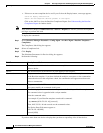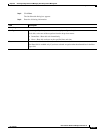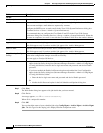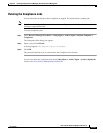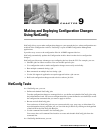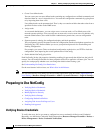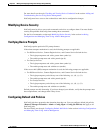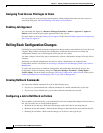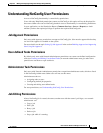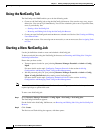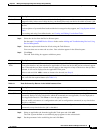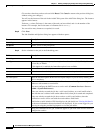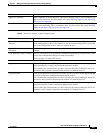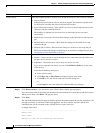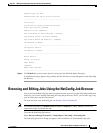
9-4
User Guide for Resource Manager Essentials 4.1
OL-11714-01
Chapter 9 Making and Deploying Configuration Changes Using NetConfig
Rolling Back Configuration Changes
Assigning Task Access Privileges to Users
You can assign task access privileges that determine which configuration tasks each user can use to
create NetConfig jobs. See
Understanding NetConfig User Permissions.
Enabling Job Approval
You can enable Job Approval, (Resource Manager Essentials > Admin > Approval > Approval
Policies) which means all jobs require approval before they can run.
For more details see the topic Setting Up Job Approval in the section Enabling Approval and Approving
Jobs Using Job Approval.
Rolling Back Configuration Changes
NetConfig lets you roll back (undo) the configuration changes made to network devices if a job does not
complete. How rollback commands (the configuration commands that are used to roll back the
configuration changes) are created depends on how the job was created.
You must configure a NetConfig job to automatically roll back configuration changes if the job fails to
complete.
NetConfig can rollback configuration only devices whose configurations are archived in the
Configuration Archive. For details see
Archiving Configurations and Managing Them Using Archive
Management.
To verify that devices have an archived configuration and troubleshoot those that do not, use the
Configuration Archival Summary dialog box (Resource Manager Essentials > Config Mgmt >
Archive Mgmt). For more details see the topic
Checking Configuration Archival Status in the section
Archiving Configurations and Managing Them Using Archive Management.
Creating Rollback Commands
You can create rollback commands for a job in the following ways:
• If you use a system-defined task, rollback commands are created automatically by the task.
• If you create a user-defined task, you can enter rollback commands into the task.
Configuring a Job to Roll Back on Failure
You can define a job failure policy so it automatically rolls back configuration changes if the job fails to
run. You can select one of several rollback options:
• Rollback device and stop—Rolls back the changes on the failed device and stops the job.
• Rollback device and continue—Rolls back the changes on the failed device and continues the job.
• Rollback job on failure—Rolls back the changes on all devices and stops the job.



